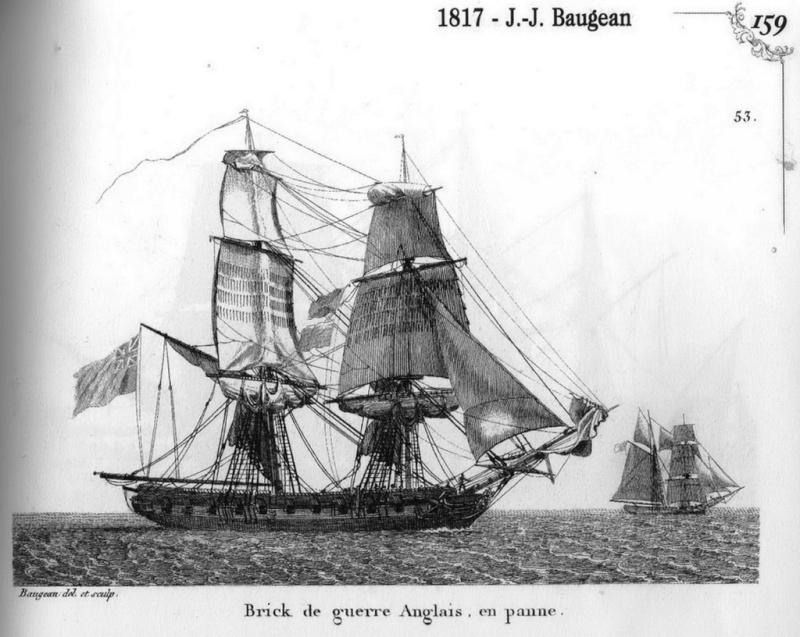Besting a French Privateer in 1807
Privateering was an integral part of sea warfare in the Age of Fighting Sail, striking as it did at the heart-blood of the enemy’s trade, commerce and economy. In an era before radio and radar privateers – essentially private business entities authorised by the home government to act as raiders – could strike without warning and, since their ships were usually chosen for speed, could make hasty getaways. (A recent post, of 17th July 2018 tells of one such incident. If you’ve missed it, click here to read it). In the course of the two decades of the Revolutionary and Napoleonic Wars vast numbers of civilian vessels, of all sizes, where captured or destroyed by these licenced rovers of all fighting nations. Such raiders did not always have it their own way however since many potential victims carried defensive armament and were ready to fight back when attacked. An excellent example of this was a British packet besting a privateer in 1807.

Brig proved invaluable and flexible assets for war or for commerce

William Rogers – Young, Handsome and Indomitable
The Windsor Castle was a “packet”, a brig chartered by the British government to carry mail. Such vessels were usually lightly armed and in this case six 4-pounder guns were carried and two 9-pounder carronades, murderous at close range. On the morning of October 1st, 1807, outbound from Britain, she sighted a French privateer, a fast-sailing schooner. This proved later to be the Jeune Richard, armed with six 6-pounders and one long 18-pounder, and she immediately gave chase. The Windsor Castle’s twenty-four year old Acting-Captain William Rogers decided to run and cracked on sail. Rogers had only twenty-eight in his crew, several of whom were “mail-tenders” who were responsible for the mails. This crew was sufficient to sail the brig – but far too few to man all the guns she carried. The Windsor Castle was therefore unlikely to be capable of putting up a long defence should the privateer overtake her. It was soon apparent that this was unavoidable. Despite the likely imbalance of forces Rogers beat to quarters and readied for action. A further consideration was that the mails carried – many likely to be confidential and sensitive – should be weighted and thrown overboard if capture was inevitable and he accordingly set some of his men to prepare for this.
By midday the privateer was within gunshot and the privateer, hoisting French colours, opened fire. Windsor Castle returned fire with her four-pounder stern-chasers. Undeterred, the French captain demanded surrender – he had a crew of ninety-two, a superiority of some three-to-one over the packet’s complement. Despite these odds Rogers refused to strike his colours. The French ship now closed, ran alongside, grappled and launched a boarding party. The Windsor Castle’s defence was so vigorous that this party was driven back, with a loss of some eight or ten men, and the Jeune Richard cut the grappling-ropes to get clear. The vessels, however, had got locked by their spars, and a desperate encounter ensued. Rogers still saw enough hope of escape that he did not give the order for jettisoning the precious mails.

Rogers boarding the Jeune Richard – by Samuel Drummond
The Jeune Richard continued to bombard the Windsor Castle, so badly that the mizzen-mast and main yard were carried away and the rigging badly damaged. Heartened by this, the French captain ordered another boarding attempt. Rogers had however crammed one of his 6-pounder carronades with grape, canister, and a bagful of musket-balls. He kept his nerve until the boarders made their rush, then fired, with devastating results. In his subsequent report Rogers stated that “Soon after this, “I embraced the opportunity of boarding, in turn, with five men, and succeeded in driving the enemy from his quarters, and about four o’clock the schooner was completely in our possession.” The carnage wrought by the carronade was horrific – twenty-one dead and thirty-three wounded out of the original French crew of ninety-two.
The Windsor Castle’s casualties were also high – three killed, and ten severely wounded – leaving her with a very depleted crew for taking possession of the Jeune Richard and the still-greater size of her surviving crew. In view of this, Rogers reported that “it was necessary to use every precaution in securing the prisoners. I was obliged to order them up from below, one by one, and place them in their own irons as they came up.”
The commander of the Leeward Islands Station, Rear-Admiral Sir Alexander Cochrane, forwarded Rogers’ report to the Admiralty with the remarks: “It is such an instance of bravery and persevering courage, combined with great presence of mind, as was scarcely ever exceeded.”
It was an assessment which is impossible to dispute.
“Antoine Vanner is the Tom Clancy of historic naval fiction“
– Author Joan Druett
Do you enjoy naval fiction?
Do you read on Kindle?
If you’re a Kindle Unlimited subscriber you can read any of the six Dawlish Chronicles novels without further charge. They are also available for purchase on Kindle or as stylish 9 X 6 paperbacks.
Click on the banner below for more details
Registering for the Dawlish Chronicles mailing list by clicking on the banner below, will keep you updated on new books and facilitates e-mail contact between Antoine Vanner and his readers for discussion of issues arising.
Suggestions and comment are always welcome and all emails are replied to. Free short stories, available only to those on the list, are also made available at intervals.


